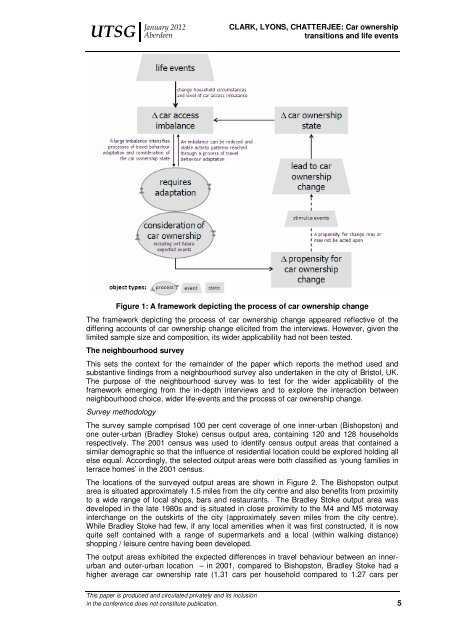Clark, B., Lyons, G. and Chatterjee, K. (2012) - UWE Research ...
Clark, B., Lyons, G. and Chatterjee, K. (2012) - UWE Research ...
Clark, B., Lyons, G. and Chatterjee, K. (2012) - UWE Research ...
Create successful ePaper yourself
Turn your PDF publications into a flip-book with our unique Google optimized e-Paper software.
UTSG<br />
January <strong>2012</strong><br />
Aberdeen<br />
CLARK, LYONS, CHATTERJEE: Car ownership<br />
transitions <strong>and</strong> life events<br />
Figure 1: A framework depicting the process of car ownership change<br />
The framework depicting the process of car ownership change appeared reflective of the<br />
differing accounts of car ownership change elicited from the interviews. However, given the<br />
limited sample size <strong>and</strong> composition, its wider applicability had not been tested.<br />
The neighbourhood survey<br />
This sets the context for the remainder of the paper which reports the method used <strong>and</strong><br />
substantive findings from a neighbourhood survey also undertaken in the city of Bristol, UK.<br />
The purpose of the neighbourhood survey was to test for the wider applicability of the<br />
framework emerging from the in-depth interviews <strong>and</strong> to explore the interaction between<br />
neighbourhood choice, wider life-events <strong>and</strong> the process of car ownership change.<br />
Survey methodology<br />
The survey sample comprised 100 per cent coverage of one inner-urban (Bishopston) <strong>and</strong><br />
one outer-urban (Bradley Stoke) census output area, containing 120 <strong>and</strong> 128 households<br />
respectively. The 2001 census was used to identify census output areas that contained a<br />
similar demographic so that the influence of residential location could be explored holding all<br />
else equal. Accordingly, the selected output areas were both classified as ‘young families in<br />
terrace homes’ in the 2001 census.<br />
The locations of the surveyed output areas are shown in Figure 2. The Bishopston output<br />
area is situated approximately 1.5 miles from the city centre <strong>and</strong> also benefits from proximity<br />
to a wide range of local shops, bars <strong>and</strong> restaurants. The Bradley Stoke output area was<br />
developed in the late 1980s <strong>and</strong> is situated in close proximity to the M4 <strong>and</strong> M5 motorway<br />
interchange on the outskirts of the city (approximately seven miles from the city centre).<br />
While Bradley Stoke had few, if any local amenities when it was first constructed, it is now<br />
quite self contained with a range of supermarkets <strong>and</strong> a local (within walking distance)<br />
shopping / leisure centre having been developed.<br />
The output areas exhibited the expected differences in travel behaviour between an innerurban<br />
<strong>and</strong> outer-urban location – in 2001, compared to Bishopston, Bradley Stoke had a<br />
higher average car ownership rate (1.31 cars per household compared to 1.27 cars per<br />
This paper is produced <strong>and</strong> circulated privately <strong>and</strong> its inclusion<br />
in the conference does not constitute publication. 5

















